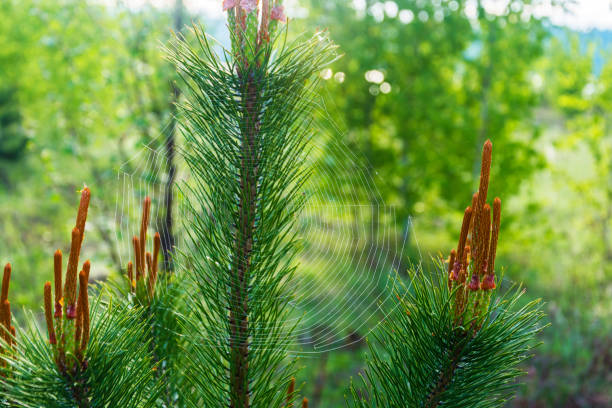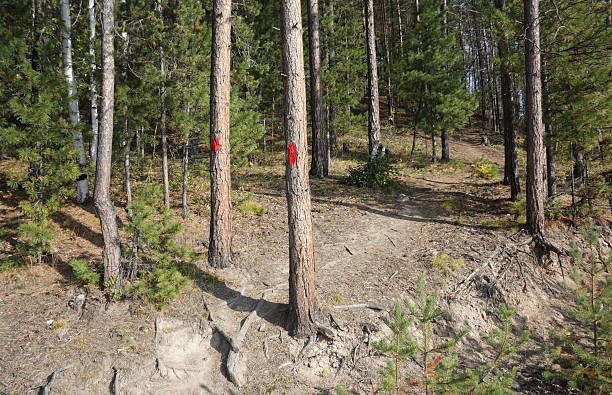
Although pine trees are lovely additions to any landscape, they are subject to illness and eventually death, just like any other living thing. It is devastating to witness these gorgeous giants deteriorate when this occurs. But don’t give up just yet! If you are aware of the warning signals and know what to do, you can often salvage a dying pine tree. We’ll guide you through the process of saving a dying pine tree in this blog post.
How to Spot Dying Pine Tree Symptoms
- You must develop your detective skills before starting your mission to save a dying pine tree. This entails getting near to your pine tree and keeping an eye out for any telltale symptoms of danger. The change in color of the needles from a bright green to a drab yellow or even brown is a definite sign of a failing pine tree. If there is little to no new growth, this could indicate that the tree’s health is in danger.
- Even while fungi are a typical component of a tree’s ecosystem, an exceptional abundance could be cause for concern. An SOS is being sent by a tree whose bark is disintegrating or mushy. Infestations of pests can be fatal to your tree in addition to being annoying. Branches that exhibit unusual drooping or leaning may be calling for assistance.
- Don’t disregard these signs; your pine tree may be silently pleading for assistance. It is feasible to stop the tree’s decline and restore it to health if these symptoms are identified in a timely manner. Like human health, pine tree health depends on acting quickly when something is wrong. So put on your detective cap and get to work on your inquiry!

Knowing the Typical Causes of Illnesses in Pine Trees
The health of your pine tree could be severely impacted by a wide range of factors. Inadequate water supply, dietary shortages, intense heat, pests, and illnesses are notable examples of these. It’s critical to identify these as possible adversaries in the life story of your tree so that you can respond appropriately.
- Did you know that pine trees frequently get root rot? Poor drainage or overwatering are common causes of this illness, which gradually deteriorates the health of your tree. Pine insects and diseases like blight and needle cast are examples of other silent destroyers. These intruders have the ability to stealthily enter your tree and destroy its health, frequently going unnoticed until the damage is done.
- In other words, figuring out what’s causing your pine tree to suffer requires more than merely admitting that something is wrong. It involves going deep—literally, in some cases—to find the precise source of the problem. With this information at hand, you may address the issue head-on and seek a solution that will help your pine tree recover.
- Like a tree doctor, you have to diagnose before you can recommend the best course of action! But fear not—all it takes is a little detective work and affection for your pine tree, not a medical degree.
Appropriate Pine Tree Watering Methods
On a hot day, picture your pine tree as a parched hiker; too little water causes it to become dehydrated, while too much results in waterlogging. The secret to the survival of your pine tree is to find the ideal moisture level. Remember to give your young, prickly pine trees a good soak once a week or two, depending on the weather where you live, to quench their thirst.
- A little more self-sufficient, mature pine trees can frequently get all the moisture they need from rainfall. But when the drought becomes really bad, they’ll really appreciate a good soak. Dig a tiny hole close to your tree to see if it gets enough water. It’s time to water if the soil is dry. Hold off if it’s dripping wet.
- A word of warning: drowning can be fatally similar to overwatering. For the tree, it’s the equivalent of drowning because it can cause root rot. To avoid this unfortunate situation, make sure the soil surrounding your tree has adequate drainage. Watering deeply as opposed to regularly is one method of doing this. This method promotes a stronger and more durable tree by encouraging roots to go deeper into the ground.
- Watering your pine tree is essentially similar to Goldilocks testing out the porridge from the three bears—it should be exactly right—not too hot or too cold, or mushy or dry! Now get your watering can, roll up your sleeves, and give your pine tree the drink it so richly deserves! Never forget that your pine tree is your canvas and that watering it is an artistic endeavor. Your tree will appreciate your attention with lush, green needles and a strong, healthy trunk if you do it correctly.
Ways to Handle Illnesses in Pine Trees
- You’ve conducted your research and found that your pine tree is fighting a sickness. Don’t worry, it’s time to put on your cape and get moving! Determine the precise nature of the illness before starting your rescue effort. After identifying the offender, you can choose the right remedy.
- For example, a fungicide may be your tree’s savior if the problem is mostly caused by a fungal disease. A careful application that complies with the directions on the product label may do wonders to restore the health of your tree. However, keep in mind that time is of the essence and that the best defense is early action.
- However, if pests are your pine tree’s worst enemy, you might have to use pesticides or even biological control techniques. In order to efficiently use nature’s own methods to restore equilibrium, these could involve introducing beneficial insects that feast on the detrimental ones.
- Perhaps your tree is suffering from root rot. If so, you might need to adjust your watering schedule or improve the drainage of your soil. After all, moderation is essential, and root rot can be prevented from spreading its harmful effects by avoiding water-logging.
Treating illnesses of pine trees is similar to acting as a knowledgeable physician who uses your expertise to identify the issue and then recommend the best course of action. Even though you might not have a degree in medicine, your passion and commitment to preserving your tree will be much appreciated. Put on your gear, jump in, and assist your pine tree in rising to its former splendor. You’re the unsung hero in this story, aiding your pine tree in defeating its enemies—after all, every hero needs a sidekick!
The Value of Pine Tree Pruning
Have you ever considered yourself to be a tree stylist? Pruning pine trees maintains their health and helps them look their best; it’s kind of like giving them a haircut! Pruning is a vital part of maintaining pine trees and helps protect them from disease and pest infestation. It’s not only a pretty technique. By cutting off those unhealthy or dead branches, you’re essentially stopping the spread of possible problems before they get worse.
- Consider it the personal bodyguard protecting your tree from damage. Furthermore, pruning not only protects but also grows! You may improve air circulation and allow sunlight to enter your space by pruning back branches. This physical breath of fresh air can encourage more vigorous and healthy development, allowing your pine tree to show off its inherent beauty.
- But be advised that you shouldn’t do this task without some knowledge. Pruning is an art, and if done incorrectly, it may cause more harm than no pruning at all. You see, each snip tells the tree where to focus its growth and resource allocation. Ignorant pruning could divert these resources from where they are most needed, making the tree weaker and less robust. It’s like to attempting to style hair without understanding the distinction between a mullet and a bob—a recipe for catastrophe!
- Thus, make sure you’ve taken the time to study the right methods before picking up those shears. And never forget that if the task appears too huge, there’s no shame in asking for assistance. Even the most skilled hair stylists require some instruction, after all. Pruning a pine tree involves figuring out what it needs to survive and applying your knowledge to give it that care. Thus, get your tools, put up your sleeves, and get ready to give your pine tree a much-needed pruning. A happier, healthier tree that will be the talk of the town (or forest) will be your prize!
Professional Arborists’ Significance in Preserving Pine Trees
There may come a point in your attempt to save your prized pine tree when you’ve run out of do-it-yourself solutions and need to call in the big guns. Relax, this is a calculated choice, not a concession of failure. It is sense to contact a professional arborist when the health of your pine tree is declining, just as you would with a complex medical issue.
- With the skills and knowledge to identify and treat diseases in trees, arborists are the superheroes of the arboreal world. They are knowledgeable with the finer points of tree health and disease since they have had extensive training in tree biology. An arborist may create a treatment plan specifically tailored to your tree’s condition, whether it’s a particularly tough pest infestation or root rot that has your tree in a chokehold.
- Additionally, arborists are capable of safely and effectively performing intricate tree care treatments. Consider tree injections as an example. Medication is injected directly into the tree using this procedure, however the exact injection technique needs to be performed by someone with specialized training to prevent additional damage. Large-scale trimming projects may also be too risky or intimidating for the typical homeowner who loves trees, but for a professional arborist, it’s all in a day’s work.
- Therefore, if, in spite of your best efforts, the health of your pine tree is declining, don’t give up. Perhaps it’s time to hand the reins over to an arborist—the medical specialist of trees. They possess the know-how to make things better and assist your pine tree in making a spectacular resurgence. You’re offering your pine tree the best chance for recuperation and a restoration to its former splendor by putting your confidence in their hands. Every patient, including your pine tree, deserves the best care available, after all!




4 Comments